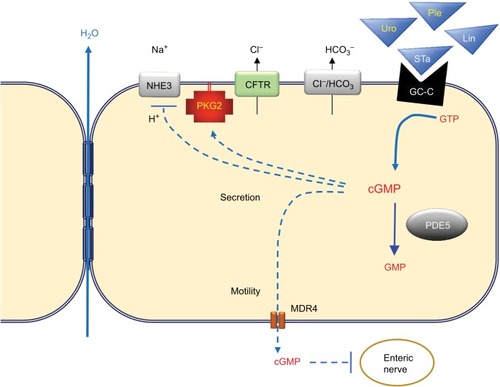Figures & data
Table 1 Pharmaceutical agents available for the treatment of constipation
Figure 1 The cyclic guanosine monophosphate (cGMP) signaling axis in the intestinal epithelium. Guanylyl cyclase C (GC-C) receptors expressed on the apical surface of intestinal epithelial cells produce cGMP from guanosine triphosphate (GTP) when bound by endogenous hormones uroguanylin (Uro) and guanylin (Gn). The synthetic peptide agonist plecanatide (Ple) mimics Uro, whereas linaclotide (Lin) mimics the heat-stable toxin from enterotoxigenic bacteria (STa). Elevated cGMP levels increase luminal solutes by blocking Na+ uptake through the sodium-hydrogen exchanger (NHE), and by activating type 2 cGMP-dependent protein kinase (PKG2), which in turn activates the cystic fibrosis transmembrane conductance regulator (CFTR). Several mechanisms restore equilibrium, including cGMP-specific phosphodiesterase 5 (PDE5) that hydrolyzes cGMP to inactive GMP, and by export of cGMP by multidrug resistance protein 4 (MDR4). Blockade of H+ exchange and secretion of HCO3− by the chloride-bicarbonate exchanger (Cl−/HCO3) increases luminal pH and reduces affinity of uroguanylin and plecanatide for GC-C (but not guanylin, linaclotide, or STa). Taken together, the stimulation of GC-C results in water secretion and reduced enteric nociception.

Table 2 GC-C agonist clinical trial data for chronic idiopathic constipation
